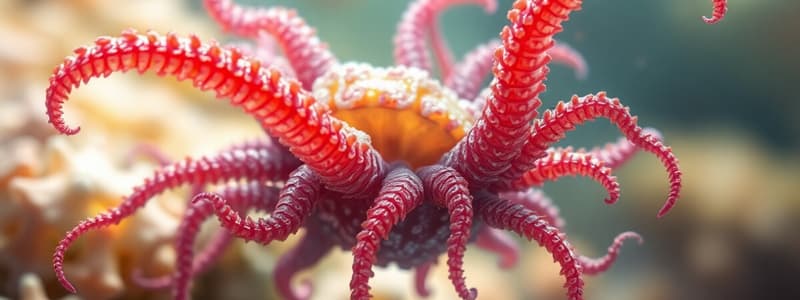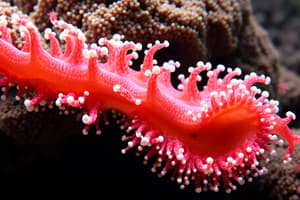Podcast
Questions and Answers
Which of the following statements accurately contrasts polyp and medusa forms in cnidarians?
Which of the following statements accurately contrasts polyp and medusa forms in cnidarians?
- Polyps have a mouth oriented upwards, adapted for capturing passing food, whereas medusae have a downward-facing mouth, suited for predation in open water. (correct)
- Polyps possess a complex nerve net with concentrated nerve rings, enabling rapid responses, whereas medusae rely on a diffuse nerve net, limiting their reactivity.
- Polyps are primarily motile, utilizing a thick mesoglea for buoyancy, while medusae are sessile, attached to substrates.
- Polyps exhibit a gastrovascular cavity specialized for intracellular digestion, contrasting with medusae, where digestion is predominantly extracellular.
How does the unique hydrostatic skeleton in cnidarians contribute to their survival in diverse aquatic environments?
How does the unique hydrostatic skeleton in cnidarians contribute to their survival in diverse aquatic environments?
- By facilitating efficient gas exchange through the body wall, as the pressurized gastrovascular cavity maximizes surface area contact with surrounding water.
- By allowing cnidarians to rapidly change their body size and shape in response to external stimuli, aiding in both prey capture and predator avoidance. (correct)
- By enabling cnidarians to maintain their body shape and structural integrity in the absence of a true skeletal system, especially in environments with fluctuating salinity levels.
- By providing a rigid framework that supports quick movements through water, particularly for medusa forms evading predators.
What ecological advantage does broadcast spawning provide to coral species, particularly in the context of environmental stressors?
What ecological advantage does broadcast spawning provide to coral species, particularly in the context of environmental stressors?
- It ensures genetic homogeneity within the coral population, promoting resistance to specific diseases prevalent in the local environment.
- It allows for targeted fertilization in sheltered locations, reducing the exposure of developing larvae to harmful UV radiation and ocean acidification.
- It synchronizes gamete release across a wide geographic area, maximizing the potential for cross-species hybridization and genetic diversity.
- It increases the likelihood of successful fertilization by overwhelming predators and diluting the impact of environmental toxins on developing larvae. (correct)
In cnidarians, how does the interplay between mechanoreception and the nerve net contribute to their predatory behavior?
In cnidarians, how does the interplay between mechanoreception and the nerve net contribute to their predatory behavior?
Which of the following scenarios would LEAST likely result in the activation of a nematocyst in a cnidocyte?
Which of the following scenarios would LEAST likely result in the activation of a nematocyst in a cnidocyte?
What is the functional significance of the mesoglea's varying thickness in polyp and medusa forms of cnidarians?
What is the functional significance of the mesoglea's varying thickness in polyp and medusa forms of cnidarians?
In what way does the division of labor among zooids in polymorphic cnidarian colonies enhance their ecological success?
In what way does the division of labor among zooids in polymorphic cnidarian colonies enhance their ecological success?
Considering the evolutionary trends within Cnidaria, which characteristic would LEAST likely be found in a newly discovered species of deep-sea jellyfish?
Considering the evolutionary trends within Cnidaria, which characteristic would LEAST likely be found in a newly discovered species of deep-sea jellyfish?
How does the phenomenon of metagenesis in certain cnidarians contribute to their overall adaptability and survival?
How does the phenomenon of metagenesis in certain cnidarians contribute to their overall adaptability and survival?
What is the primary mechanism by which cnidarians, lacking respiratory and circulatory systems, facilitate gas exchange and nutrient distribution at the cellular level?
What is the primary mechanism by which cnidarians, lacking respiratory and circulatory systems, facilitate gas exchange and nutrient distribution at the cellular level?
Which of the following statements correctly evaluates the evolutionary significance of cnidocytes in the phylum Cnidaria?
Which of the following statements correctly evaluates the evolutionary significance of cnidocytes in the phylum Cnidaria?
How does the absence of organs in cnidarians influence their physiological capabilities and ecological interactions?
How does the absence of organs in cnidarians influence their physiological capabilities and ecological interactions?
What role do environmental cues play in coordinating synchronous spawning events in coral reef ecosystems, and how might climate change disrupt these processes?
What role do environmental cues play in coordinating synchronous spawning events in coral reef ecosystems, and how might climate change disrupt these processes?
Which of the following represents the MOST significant difference in the life cycle strategies between Hydrozoa and Anthozoa?
Which of the following represents the MOST significant difference in the life cycle strategies between Hydrozoa and Anthozoa?
Considering the structural and functional differences between nerve nets and nerve rings in cnidarians, which statement accurately reflects their respective roles in mediating behavior?
Considering the structural and functional differences between nerve nets and nerve rings in cnidarians, which statement accurately reflects their respective roles in mediating behavior?
Flashcards
Phylum Cnidaria
Phylum Cnidaria
Phylum including soft-bodied stinging animals like corals, sea anemones, and jellyfish.
Cnidocytes
Cnidocytes
Cells containing a fluid-filled capsule (cnida), used for defense and capturing prey.
Polyp
Polyp
The hydroid form of cnidarians, sessile with mouth-up orientation.
Medusa
Medusa
Signup and view all the flashcards
Epidermis
Epidermis
Signup and view all the flashcards
Gastrodermis
Gastrodermis
Signup and view all the flashcards
Mesoglea
Mesoglea
Signup and view all the flashcards
Coelenteron
Coelenteron
Signup and view all the flashcards
Asexual Reproduction
Asexual Reproduction
Signup and view all the flashcards
Mechanoreception
Mechanoreception
Signup and view all the flashcards
Chemoreception
Chemoreception
Signup and view all the flashcards
Photoreception
Photoreception
Signup and view all the flashcards
Statocyst
Statocyst
Signup and view all the flashcards
Hermaphrodite
Hermaphrodite
Signup and view all the flashcards
Hydrostatic Skeleton
Hydrostatic Skeleton
Signup and view all the flashcards
Study Notes
- Phylum Cnidaria includes soft-bodied stinging animals like corals, sea anemones, and jellyfish
- The name Cnidaria comes from the Greek word "cnid," meaning nettle (a stinging plant)
- Cnidarians inhabit many aquatic environments
- They range in size from tiny to graceful giants with trailing tentacles several meters long
- Cnidarians are diploblastic eumetazoans with a tissue grade of organization
- Cnidarians are characterized by cnidocytes and polyp/medusa forms
General Characteristics of Phylum Cnidaria
- Most are marine, but some (like Hydra) live in freshwater
- Many are colonial (e.g., corals)
- Some are solitary (e.g., sea anemones)
- Body is radially symmetric, but sea anemones show biradial symmetry
- Polyp (hydroid) is sessile with mouth-up
- Medusa is umbrella/bell-shaped with mouth-down and swims by constricting the bell
- The body wall has an outer epidermis and an inner gastrodermis with mesoglea in between
- Mesoglea consists of amoeboid cells from ectoderm and is thin in polyps and thick (for buoyancy) in medusa
- The body wall contains stinging cnidocytes containing a fluid-filled capsule called cnida used for defense and prey capture
- The gastrovascular cavity (coelenteron) is a blind sac that opens via a mouth surrounded by tentacles used for ingestion and egestion
- In medusa, the coelenteron is specialized into a stomach, radial canals, and a ring canal for digestion and circulation
- Digestion begins extracellularly in the coelenteron and finishes intracellularly in gastrodermis cells
- Gas exchange and excretory waste removal occur by diffusion through the body wall
- Neurons form a pair of nerve nets, one in the epidermis and the other in the gastrodermis, joined by neurons crossing the mesoglea
- Nerve impulse conduction is diffuse and can travel in any direction
- Medusae have nerve rings and ganglia around the bell margin
- Sensory structures like statocysts occur in the medusoid form
- Asexual reproduction occurs by budding, fission, and fragmentation
- Cnidarians are mostly unisexual, but some are bisexual with external fertilization and holoblastic cleavage
- Development is indirect, including a free-swimming ciliated larval stage called planula
- Species with both polyp and medusa phases alternate asexually reproducing polyp and sexually reproducing medusa forms (metagenesis)
- Cnidarians have remarkable regeneration abilities
Classification of Phylum Cnidaria
- Phylum Coelenterata/Cnidaria has about 10,000 species in three classes: Hydrozoa, Scyphozoa, and Anthozoa
Class I: Hydrozoa
- Mostly marine, but some live in freshwater
- Chiefly colonial but can be solitary
- Medusa stage absent in some
- Medusa is craspedote (has a velum)
- Polyps have an undivided coelenteron
- Mesoglea is acellular
- Cnidocytes are restricted to the epidermis
- Gonads occur in the epidermal region
- Colonies are polymorphic with gastrozooids (feeding), dactylozooids (defense), and gonozooids (reproduction)
Class II: Scyphozoa
- All marine
- Medusa stage is predominant and acraspedote (no velum)
- The mouth is surrounded by four oral arms
- Mesoglea is cellular and contains amoebocytes
- Cnidocytes are in the epidermis and gastrodermis
- Gonads are in the gastrodermal region
- Polyps are solitary or colonial with a polyp stage called a scyphistoma which forms juvenile medusa (ephyrae) by strobilation; the ephyra grows into an adult medusa
Class III: Anthozoa
- All marine
- Solitary or colonial
- All are sedentary polyp forms, with no medusa stage
- Mouth is oval, surrounded by tentacles resembling a flower
- The mouth leads to a stomodaeum (tubular pharynx) that opens into the coelenteron, which is divided by mesenteries
- Cnidocytes occur in the epidermis and gastrodermis
- Gonads occur in the gastrodermis
Cnidarian Body Structure
- Body layers surround the gastrovascular cavity, which extends into hollow tentacles
- Cnidarians generally have radial symmetry
- Cnidarians have polyp and medusa structural forms.
- The polyp is a cylinder/bag with a mouth and tentacles at the top, attached to a surface and has a thin mesoglea
- The medusa is umbrella-shaped with a mouth and tentacles hanging down, motile, and has a thick mesoglea
Cnidocytes and Nematocysts
- Cnidarians have stinging cells called cnidocytes containing a nematocyst
- A nematocyst is a coiled, tubular harpoon-like structure (thread and bag) that is inverted
- Upon stimulation by touch or chemoreception, the nematocyst fires outward and injects venom
- Each nematocyst is used only once, replaced by new cnidocytes and they are specific to different species
Feeding and Support
- Cnidarians are carnivorous predators
- Jellyfish capture small animals with cnidocyte-filled tentacles
- Sessile coral polyps and sea anemones sting prey, grasp it with tentacles, and put it in their mouth
- Venom potency differs among species; some are toxic to humans
- Sea anemones and jellyfish use a hydrostatic skeleton and fill the gastrovascular cavity with water for support
- Coral polyps have a hydrostatic skeleton but often sit in a hard limestone skeleton
Other Systems
- Cnidarians lack organs and respiratory/circulatory systems
- Cells get oxygen directly from the water and nutrients pass through the liquid between cells
- Cnidarians have a simple nervous system (nerve net) for responding to stimuli through impulses to muscle cells
- They have mechanoreception (touch/pressure) and chemoreception (chemical stimuli, taste/smell)
- They also have photoreception (light intensity); box jellies have image-forming eyes, and most jellyfish have a statocyst for sensing direction
Movement
- Cnidarians respond to stimuli via muscle cells; vertical bands shorten the body, and circular muscles close the mouth
- Jellyfish use an umbrella shape of mesoglea; muscle contraction forces water out and propels them forward
- Most jellyfish are poor swimmers and therefore classified as plankton
Reproduction
- Cnidarians reproduce sexually and asexually.
- Some are simultaneous hermaphrodites, releasing egg-sperm bundles
- Others are either male or female
- Many coral species reproduce externally via broadcast spawning triggered by environmental cues
- Some cnidarians have internal fertilization
- After fertilization in broadcasting spawners, a larva grows with cilia; these are also considered plankton
- Cnidarians can reproduce asexually by budding or fragmentation to form large colonies
- They can regenerate lost or damaged parts; some can form entire new organisms from detached tissue
Studying That Suits You
Use AI to generate personalized quizzes and flashcards to suit your learning preferences.




